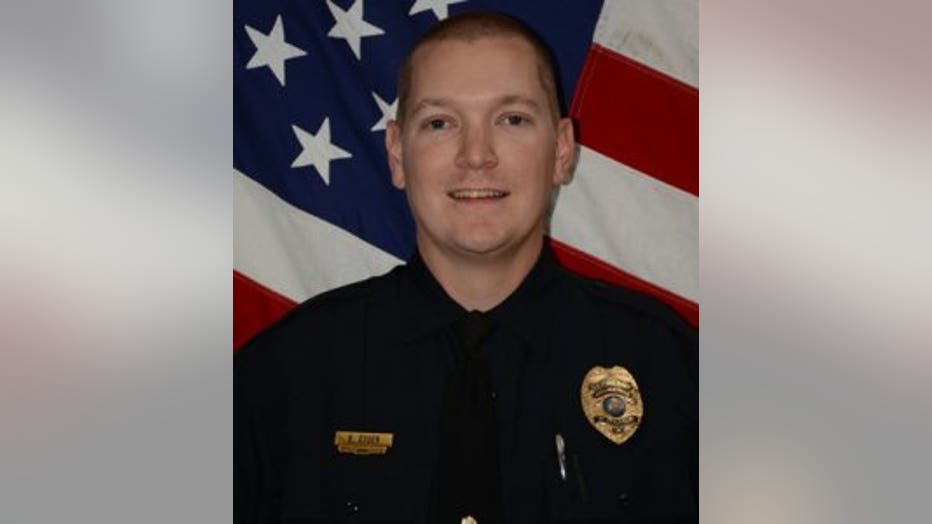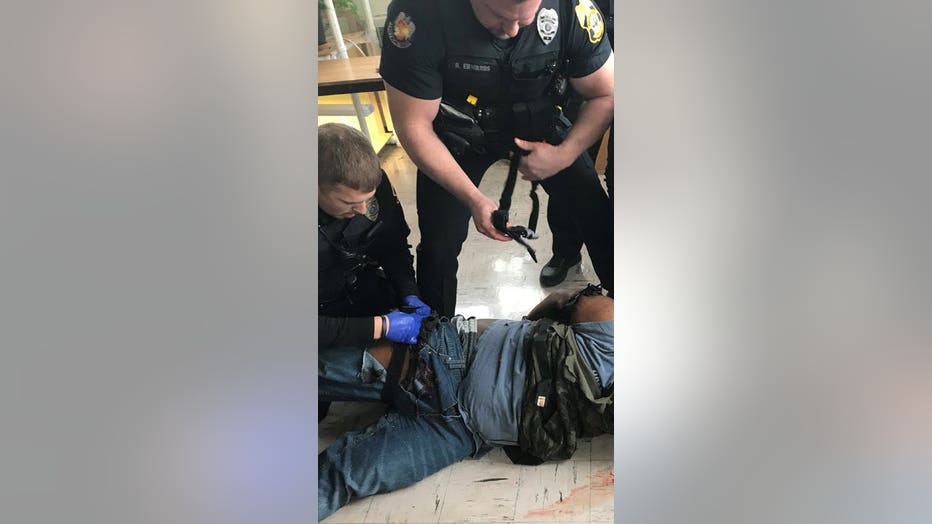Waukesha South student who pointed gun at officers had 2nd weapon in backpack: 'He was angry'
WAUKESHA -- Waukesha police said the 17-year-old student who pointed a gun at officers inside a classroom at Waukesha South High School on Monday, Dec. 2 had a second weapon in his backpack. Both weapons were identified as pellet guns.
Police Chief Russell Jack started a news conference Tuesday afternoon, Dec. 3 by thanking the Waukesha community -- and especially the students of Waukesha South High School.
"You did exactly as you were trained," said Chief Jack. "You saw something and you said something. That information allowed the school resource officer, Waukesha South staff, and students to react as trained, and assisted in preventing the situation from spreading throughout the school, thus mitigating harm to others."

What happened

Sgt. Brady Esser
Officials said the SRO received information the 17-year-old student had a gun in the classroom -- and that he had pointed it at a student's head. The SRO and a detective were able to get to the classroom -- and the remaining teacher and students were able to evacuate the room. While the detective was speaking with the 17-year-old, officials said he pulled a gun from his hoodie and pointed it at the officers. The detective, identified as Sgt. Brady Esser (an 11-year veteran of the Waukesha Police Department), discharged his weapon based on the imminent threat.
Police said the 17-year-old student was shot once in his right leg and twice in his right arm. Chief Jack said he was taken to Children's Wisconsin where he was listed in stable condition.

Photo shows officers immediately render aid to Waukesha South student shot
Again, the weapon was recovered. It was later determined to be a pellet gun. A second weapon, also a pellet gun, was found in the 17-year-old boy's backpack, police said.
What was his motive? Capt Dan. Baumann told reporters, "He was angry." Baumann clarified later, saying he was angry with another student -- the one he pointed the weapon at.
While classes resumed on Tuesday, this incident clearly shook the community. Some students opted to stay home.
"I'm getting a little bit better now, but some of my friends are not going to school," said Alexis Bell, a junior.
Capt. Baumann also said there was no connection between this incident at Waukesha South High School -- and an incident that unfolded at Waukesha North.
On Monday afternoon, it was reported that a Waukesha North High School student was in possession of a firearm, and a school resource officer believed there was a possibility that student was inside the school.
The school was placed on lockdown and searched.
A 15-year-old boy was located in a residence on Gascoigne Drive in the City of Waukesha -- and was taken into custody.
Similar incident in Oshkosh Tuesday
Tuesday's news conference came hours after a 16-year-old student was shot by an officer at Oshkosh West High School.
According to Oshkosh Police Chief Dean Smith, officers responded at 9:14 a.m., approximately two minutes after they were called, and immediately entered the school. Chief Smith said the officer and the student got into an “altercation” in the officer’s office, the student stabbed the officer with an edged weapon — Smith declined to elaborate — and the officer opened fire with his 9 mm pistol, hitting the student once. It’s unclear how many times the officer may have fired.
On Tuesday afternoon, Oshkosh police said they were investigating a comment written on the Oshkosh Police Department’s Facebook page under the post about the officer-involved shooting that occurred at Oshkosh West on Tuesday morning -- implying a possible threat towards Oshkosh North High School.
Police said an investigation led them to believe students were not in danger, and this comment was not meant to be a threat against Oshkosh North High school.
Role of teachers, police in schools
The debate about the role of armed teachers or police in schools has been a constant in the wake of school shootings across the country. But rarely have armed resource officers been able to prevent a shooting.
An estimated 43% of public schools have armed officers on campus, according to a survey by the National Center for Education Statistics. The survey covered the 2015-2016 school year, the most recent year surveyed. That figure doesn’t include schools with armed private security guards or teachers and administrators who carry guns.
The U.S. Department of Justice has adopted best practices for resource officers from the National Association of School Resources. Those guidelines call for resource officers to serve as police officers as well as teachers and mentors.
NASRO recommends such officers have three years of experience and says they should be willing to engage with students and have excellent communication skills. They should complete a school-based policing course before being assigned to the beat and complete an advanced school policing course NASRO provides within a year of completing the basic course. They also should complete bi-annual training on how lone officers should handle threats and assailants.
No Wisconsin laws spell out any special requirements for resource officers or restrictions on their weapons. But the state Department of Justice has adopted best practices similar to NASRO’s recommendations, calling for officers to work with schools on the extent of their duties, the skills they need, and where school discipline ends and illegal conduct begins. The state guidelines also suggest officers receive training in child development, restraint policies and de-escalation strategies.
Response to school shootings
As school shootings have become more frequent, gun rights advocates and gun control advocates have sparred over how best to respond to them. Supporters of gun restrictions have argued that putting more guns in schools does little to prevent shootings and just puts students at greater risk.
Last year, for example, armed guards at three high-profile school shootings — Marshall County High School in Benton, Kentucky; Majory Stoneman Douglas High School in Parkland, Florida; and Santa Fe High School in Texas — were unable to stop those shootings. In Parkland, the school’s resource officer remained outside rather than enter the building to engage the shooter and try to stop it.
But gun-rights advocates believe having more armed educators and law enforcement in schools will help stop a shooter from going on a rampage.

